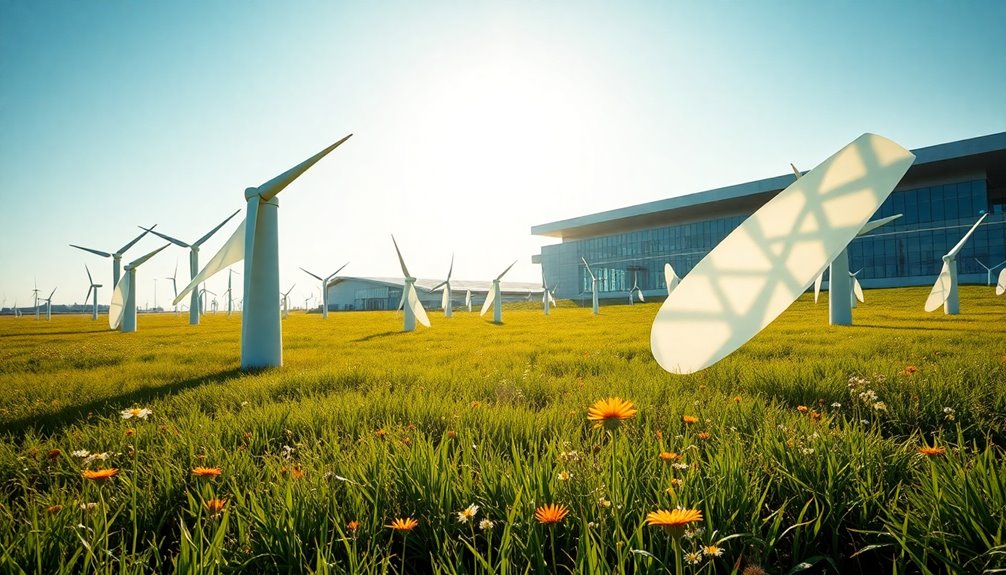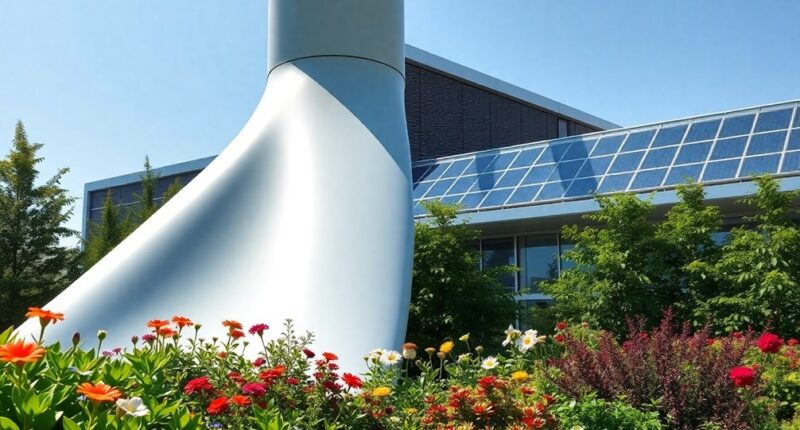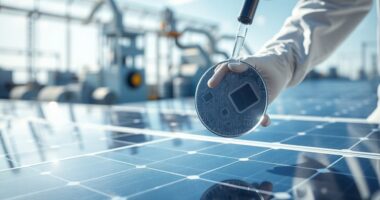Reusing wind turbine blades plays a crucial role in a circular economy, transforming waste into valuable resources for infrastructure projects. By leveraging innovative recycling technologies, you can help reduce costs by up to 73% while significantly cutting CO2 emissions. Repurposing these durable materials not only conserves resources but also enhances the structural integrity of new developments. Join the movement to innovate and drive sustainability forward—there's much more to discover about this exciting opportunity.
Key Takeaways
- The circular economy model emphasizes the reuse and recycling of decommissioned wind turbine blades, mitigating waste and promoting sustainability.
- Innovative recycling technologies like mechanical grinding and pyrolysis are being explored to enhance the recovery of materials from turbine blades.
- Repurposing blades can lead to significant cost savings, reducing expenses in infrastructure projects by up to 73%.
- Reusing turbine blade materials not only conserves resources but also contributes to reduced CO2 emissions and enhanced structural integrity in new applications.
- Policy support and infrastructure expansion are essential to overcome challenges in recycling and to foster a sustainable circular economy for wind turbine blades.

As the global installed wind power capacity surged by 50% in 2023, reaching an impressive 1 terawatt, the challenge of managing decommissioned wind turbine blades has become increasingly urgent. These blades, made from composite materials, present a significant waste management dilemma. However, the circular economy model offers a path forward, emphasizing reuse and recycling. Several innovative recycling technologies, such as mechanical grinding and pyrolysis, are being explored to tackle this issue.
The European wind industry even aims for 100% reuse, recycling, or recovery of end-of-life blades by 2025, a commitment that aligns with global sustainability goals. Repurposing these blades can lead to substantial cost savings, with infrastructure projects like overhead sign structures benefiting from reduced expenses by up to 73%. The high strength-to-weight ratio of the blades makes them ideal for various structural applications, allowing you to conserve resources while reducing waste. Moreover, repurposed blades maintain their durability, contributing to long-lasting infrastructure that supports sustainable development. By reusing these materials, you can significantly reduce CO2 emissions, helping to achieve climate goals. Furthermore, the high strength-to-weight ratio of decommissioned wind turbine blades can be leveraged to enhance the structural integrity of new infrastructure projects.
The European wind industry is committed to achieving 100% reuse, recycling, or recovery of end-of-life blades by 2025.
Despite these advantages, challenges remain. The complex materials in wind turbine blades, including fiberglass and carbon fiber, complicate recycling efforts. Additionally, separating composite materials and the high transportation costs due to the size of the blades limit recycling initiatives. Currently, few facilities are equipped for large-scale blade recycling, and market demand for recycled materials remains uncertain.
To overcome these barriers, strategies such as developing new materials, providing incentives for early adoption, and increasing policy support can enhance recycling rates. Expanding recycling infrastructure and embracing technological innovations will also help address current limitations.
Frequently Asked Questions
What Materials Are Used in Wind Turbine Blades?
Wind turbine blades are primarily made from composite materials, which combine fibers like glass and carbon with matrix materials such as thermosets, including epoxies and polyesters.
These materials create strong, lightweight structures capable of withstanding various loads. The blades often feature sandwich structures, enhancing weight efficiency.
When designing these blades, manufacturers use methods like vacuum infusion and pre-preg techniques to ensure durability and optimize performance in diverse environmental conditions.
How Long Do Wind Turbine Blades Last?
Did you know that wind turbine blades typically last between 20 to 25 years? Their lifespan largely depends on factors like material quality and environmental conditions.
If you're considering wind energy, remember that offshore turbines often have better durability due to less weather exposure. However, operational variability means some blades might last longer or shorter than expected.
Regular maintenance can also significantly enhance their longevity, ensuring you get the most out of your investment.
What Are the Environmental Impacts of Turbine Blade Disposal?
When you consider the environmental impacts of turbine blade disposal, it's clear they pose significant challenges.
Blades take up considerable landfill space and are made from materials that resist decomposition, leading to long-term waste issues.
Furthermore, using landfills squanders valuable resources that could be recycled.
The complexity of their materials complicates recycling efforts, making it crucial for you to think about innovative solutions that could mitigate these environmental concerns effectively.
How Are Old Blades Transported for Reuse?
Transporting old blades is like maneuvering a giant puzzle piece through a maze. You're faced with the challenge of their size and weight, navigating narrow roads and low bridges.
Specialized vehicles become your trusty steeds, while mobile shredding services can help you carve them into manageable sections.
Route planning is crucial—every mile counts, impacting both your costs and the environment. By optimizing these routes, you can make the journey smoother and greener.
What Industries Can Benefit From Reused Turbine Blades?
You'll find that several industries can benefit from reused turbine blades.
The construction industry can use them in materials for buildings and bridges, enhancing sustainability.
Transportation sectors can create durable bus and bike shelters.
Urban development can integrate them into public furniture, promoting eco-friendly designs.
Additionally, manufacturing can recycle fiberglass from the blades into new composite materials, reducing reliance on virgin resources and fostering innovation across various sectors.
Conclusion
In embracing the circular economy, you're not just preserving resources; you're breathing new life into wind turbine blades. By creatively repurposing these structures, you're nurturing innovation while gently steering away from wastefulness. This approach fosters a sustainable future, where every component plays a vital role in our infrastructure. So, as you look to the horizon, remember that each blade holds untapped potential, inviting you to be part of a greener tomorrow.









